![]()
![]()
![]()
Use LEFT and RIGHT arrow keys to navigate between flashcards;
Use UP and DOWN arrow keys to flip the card;
H to show hint;
A reads text to speech;
376 Cards in this Set
- Front
- Back
|
What is an atelectases?
|
Anything that keeps the lungs from expanding.
|
|
|
What is Chronic Obstructive Pulmonary Disorder?(COPD)
|
A combination of emphysema and chronic bronchitis.
|
|
|
What is emphysema?
|
Overinflated alveoli. Loss of alveolar recoil so exhalation goes down.
|
|
|
What causes emphysema?
|
A combination of infection and genetics. With infection, macrophages fight the infection with trypsin that damages the elastin (the recoil) on the alveolar walls. With genetics, if you receive one gene for the enzyme alpha-1 anti-trypsin, then it should appear at an older age if the person smokes. If no genes, then will get emphysema young, even without smoking. If two genes then won't get it.
|
|
|
What are the symptoms of emphysema?
|
- There is blocked lung expansion
- poor exhale - dyspnea - nail clubbing - increase in chest size causing "barrel chest" - weight loss as disease progresses - Termed "pink puffers". |
|
|
How do you treat emphysema?
|
- Surgery to remove the over-expanded lung tissue to allow expansion of the healthy lung tissue
- standard PT - bronchodilators - oxygen - teaching of "pursed-lip" breathing - anti-trypsin drug replacement therapy. |
|
|
What is chronic bronchitis?
|
Infected bronchi or bronchioles for two or more months for two years in a row.
|
|
|
What puts you at risk for bronchitis?
|
- Asthma
- smoking (paralyzes the cilia) - smog or pollution exposure. (ASS) |
|
|
What are the symptoms of bronchitis?
|
- Productive cough
- halitosis - thick sputum - increase in mucus. Over time the mucus glands increase. - Scarring secondary to infections - dyspnea - wheezing and/ or crackles - cor pulmonale - edema - cyanosis - Termed "Blue Bloaters". (B for bronchitis and blue) |
|
|
What is Cor Pulmonale?
|
Right sided heart failure.
|
|
|
Based on what we're studying right now, what causes cor pulmonale?
|
Both chronic bronchitis and emphysema will cause cor pulmonale, but chronic bronchitis will cause it earlier than emphysema.
|
|
|
What is acute bronchitis?
|
The rapid onset of infected bronchi or bronchioles. Could also be asthmatic bronchitis with wheezing.
|
|
|
What are the symptoms of acute bronchitis?
|
- Lots of mucus
- asthmatic symptoms - fever - possibly halitosis - Could potentially progress into epiglottitis and pneumonia. |
|
|
What is bronchiectasis?
|
Dilated bronchi or bronchioles enlarged by infection or abscess and is permanent.
|
|
|
What does bronchiectasis do?
|
Traps other infections, increasing risk of other infections and causes chronic infections.
|
|
|
What causes bronchiectasis?
|
Any obstruction of the lungs;
- cystic fibrosis - coal miner's lung - asbestos, etc. |
|
|
What are the symptoms of bronchiectasis?
|
Cough
Fever Yucky smelling sputum Dyspnea Orthopnea Eventually right-sided failure (cor pulmonale) |
|
|
What is orthopnea?
|
Postural dyspnea.
|
|
|
What is asthma?
|
Panting. Spasm or constriction of the smooth muscle in the airways and increased mucus production. There are three types.
|
|
|
What are the types of asthma?
|
Extrinsic
intrinsic exercised induced. |
|
|
Describe extrinsic asthma.
|
Typically affects children that are reacting to something they're allergic to. There is an increase in IgE. Some kids may grow out of it.
|
|
|
Describe intrinsic asthma.
|
Usually adults reacting to just about anything such as perfume, cold air, dry air, etc.
|
|
|
Describe exercised induced asthma.
|
Osmotic theory refers to dry air (as there is in gyms) and the thermal theory refers to the cold air going in and the hot air going out, back and forth, when exercising outside. It is more common during the winter.
|
|
|
What are the symptoms of asthma?
|
Wheezing
decreased FEV1 decreased breathing sounds crackles cough - dry or productive not coughing because they can't breathe. |
|
|
What is FEV1 and what should the percentage be?
|
The percentage of exhaled air in 1 second. Should be 80%.
|
|
|
What's happening when an asthmatic is seriously struggling?
|
Low oxygen
Increased heart rate cyanosis or pallor They start to get sleepy |
|
|
What is the treatment for asthma?
|
Rescue inhalers
bronchodilators Anti-inflammatory steroids (cortisone & Prednisone) |
|
|
What do we want to try and do with asthma patients?
|
Keep them from having crisis' because we can get hypertrophy of the smooth muscle (making the airways smaller) and also hypertrophy of the mucus glands which restricts the airway.
|
|
|
What are Restrictive Pulmonary Disorders?
|
Disorders that decrease the ability to inhale from the outside (like the rib cage or from the lung walls). An example may be the ECM getting too thick. It is holding the lungs so they can't get bigger to inhale.
|
|
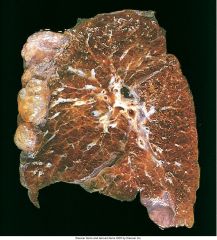
What is this a picture of?
|
Emphysema
|
|
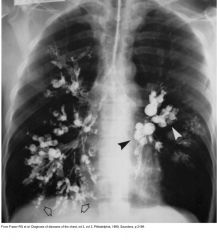
What does this patient have and what are the arrows pointing to?
|
Bronchiectasis. The bubbles are infections and pus.
|
|
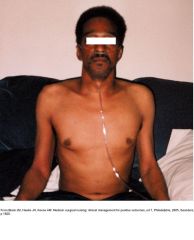
What does this patient have and how do we know?
|
COPD because he is a "pink puffer".
|
|
|
What is pulmonary fibrosis and what are the kinds?
|
Damaged and scarred lung tissue. There are three kinds;
- pneumoconiosis - sarcoidosis - hypersensitivity pneumonitis. |
|
|
What are the symptoms of pulmonary fibrosis?
|
- The damage is in the alveolar walls.
- Initially there are no symptoms, then can't exercise. - Progressively becomes worse until there's dyspnea all the time. - Clubbing and right sided heart failure happens in advanced stages. - Is progressive and slow. |
|
|
What triggers pneumoconiosis?
|
Air particles are the trigger such as
- coal dust - asbestos - fabric particles as from a factory with polartec material. |
|
|
Describe sarcoidosis.
|
- It is inflammatory.
- Affects lungs and the skin - Is Autoimmune - Idiopathic - Has type IV granulomas (T-cell mediated) - usually in the lymph nodes and lungs (but can be in other areas) |
|
|
What kinds of people typically get sarcoidosis?
|
Scandinavians
British African Americans Affects more women than men. |
|
|
What are the symptoms of sarcoidosis?
|
- trouble breathing
- fever - nodules are painful - arthritis type symptoms - big fleshy lesions or lumps - about half resolve on their own after 1 - 2 years - other half will have permanent lung damage and will progress |
|
|
Describe hypersensitivity pneumonitis.
|
- type III hypersensitivity
- occupational (reacting to something inhaled in the workplace) - are in the lungs - sick building syndrome - trouble inhaling - start fever, not feeling well, dyspnea, malasia 4 -6 hours after getting to work - causes inflammation and scarring of the lungs |
|
|
What are the restrictive pulmonary disorders?
|
Pulmonary Fibrosis
Pleural Effusions Disorders of the chest wall |
|
|
What are the disorders of the chest wall?
|
Kyphosis
Scoliosis Severe Obesity |
|
|
What are pleural effusions?
|
Fluid buildup between the pleural membranes, limiting the expansion of the lungs during inhalation.
|
|
|
How many different kinds are pleural effusions are there and what are they?
|
Five
1. Transudate - serum 2. Exudate - proteins and fluid 3. Hemothorax - blood 4. Chylothorax - lymphatic fluid from trauma 5. Pneumothorax - air |
|
|
Desribe Transudate.
|
Serum fills the space between the pleural membranes. From pulmonary edema and / or result of left sided heart failure.
|
|
|
Describe Exudate.
|
Proteins and fluid fill between the pleural membranes. Caused by infection, sarcoidosis, lung cancer, with pulmonary embolis. Also causes friction from the proteins.
|
|
|
Describe hemothorax.
|
- From trauma.
- Blood in the pleural cavity. - There is friction as well as trouble breathing (expanding the lungs). - There is risk of lung collapse. |
|
|
Describe Chylothorax.
|
- From trauma.
- Lymphatic fluid in the lungs. - TB increases risk - risk of lung collapse |
|
|
Describe pneumothorax.
|
Air is leaking into the pleural cavity. There are two kinds; spontaneous and traumatic.
|
|
|
Describe Spontaneous pneumothorax.
|
- Air is leaking from the alveoli into the cavity.
- Can happen with TB or emphysema. - Can happen with rapid growth of a child. |
|
|
Describe Traumatic pneumothorax.
|
- Air is leaking into the pleural cavity from a punctured lung from the alveoli or from outside the rib cage (sucking chest wound).
|
|
|
What is the difference between the pneumothorax and all the other kinds of pleural effusions?
|
Transudate, exudate, hemothorax and chylothorax all have fluid filling the pleural space where the pneumothorax has air filling the space. With a pneumothorax, the heart may shift to the side of a lung collapse, risking heart failure. The diaphragm will rise on that side.
|
|
|
How do you treat pulmonary fibrosis?
|
Depends on the cause. Treatment is mostly supportive; - anti inflammatories
- bronchodilators - anti scarring drugs - lung transplant |
|
|
What is kyphosis?
|
A convex curvature of the spine. Can Cause breathing problems.
|
|
|
What is scoliosis?
|
An abnormal lateral curvature of the spine. Can cause breathing problems.
|
|
|
What is the pickwickian syndrome?
|
Severe obesity. A layer of fat develops between the diaphragm and the lungs causing difficulty breathing.
|
|
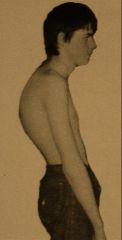
What is this a sign of?
|
Kyphosis
|
|
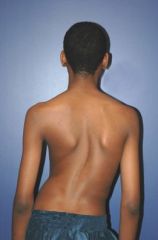
What is this a sign of?
|
Scoliosis
|
|
|
What is Cystic Fibrosis?
|
An autosomal recessive genetic disorder that causes the body to create thick, viscous mucus instead of normal mucus. There is a problem with the Affects the lungs, pancreatic ducts and the liver. Patient gets repeat respiratory infections due to mucus trapping bacteria.
|
|
|
Who is at risk for Cystic Fibrosis?
|
Genes for this condition run significantly in European heritage. It is very uncommon in Asian heritage. A carrier is protected from dying from diarrhea.
|
|
|
How is Cystic Fibrosis diagnosed?
|
An infant born may have blocked meconium, salty sweat and failure to thrive despite eating and pooping. May also get repeat respiratory infections.
|
|
|
What is the treatment for cystic fibrosis?
|
- digestive enzymes
- mucolytics - antibiotics for the infections - a vibration vest to help cough out mucus - may need a lung or heart/ lung transplant - may eventually get diabetes - may eventually need fertility treatments |
|
|
What is Infant Respiratory Distress Syndrome?
|
Babies born premature, less than 7 1/2 months gestation, the age where they start making surfactant to break up the water tension to help in breathing.
|
|
|
How is infant respiratory distress syndrome treated?
|
If there is a risk of the baby being born premature, they may give the mother steroids to help the baby's lungs mature quicker. If the mother is stressed, the baby is likely to have better lungs.
|
|
|
How is infant respiratory distress syndrome diagnosed?
|
- Baby's nostrils may flare
- baby may grunt when breathing - baby's chest may retract - may start foaming in the lungs and airways may go down - then vitals will start to crash. |
|
|
What is a pulmonary embolus?
|
A blood clot in an artery to the lungs causing vasoconstriction, which triggers the sympathetic nervous system. HR goes up, BP goes up. If 1/4 of the lung function is blocked, may cause cor pulmonale, or right sided heart failure.
|
|
|
How is a pulmonary embolus treated?
|
Oxygen and blood thinners.
|
|
|
What is pneumonia?
|
An infection of the alveoli. The lungs fill with fluid.
|
|
|
Who is at risk for pneumonia?
|
- Anyone stuck in bed or wheelchair bound
- Anyone on an anesthetic - Anyone with difficulty breathing |
|
|
What kinds of pneumonia are there?
|
Bacterial
viral fungal. |
|
|
What are the symptoms of pneumonia?
|
- Decreased breathing sounds
- crackles - whines - bronchial sounds - fever - shortness of breath - sometimes a productive cough - x-ray shows shadows |
|
|
What can happen with bacterial pneumonia?
|
An endotoxin can be released causing the patient to bleed into the lungs and can possibly cause death.
|
|
|
What can happen with the bird flu?
|
Can cause pneumonia with massive inflammatory edema in younger patients and is more likely to kill younger people than older ones.
|
|
|
What is turberculosis (TB)?
|
A common and often fatal infectious disease caused by various strains of mycobacteria.
|
|
|
What happens during a TB infection?
|
A macrophage takes the mycobacteria, which lives inside the cells in chains, to a lymph node in the lungs. Tries to create a granuloma around it. It scars around the granuloma to isolate it and slow the infection. The disease will flare, possibly from stress. Will see caseous necrosis because the T-cells get involved. Type IV sensitivity. Will recover from flare and TB gets knocked down but progresses a bit more.
|
|
|
What symptoms appear with TB?
|
- low grade fever
- cough - night sweats - weight loss - crackles - nodules on x-ray - start to have productive cough |
|
|
How is TB treated?
|
Anti tuberculosis drugs - make sure they work first. Infectious control.
|
|
|
What causes lung cancer?
|
- Smoking
- secondary smoke - asbestos - radon exposure - sometimes idiopathic |
|
|
What are the symptoms of lung cancer?
|
- early on, may lose voice
- hormonal changes - trouble breathing late in infection |
|
|
What is carbon monoxide poisoning?
|
Poisoning of the hemoglobin in the RBCs.
|
|
|
What causes carbon monoxide poisoning?
|
Carbon monoxide is produced by things burning or not functioning properly. The poisoning is caused by exposure to the carbon monoxide.
|
|
|
What are the symptoms of carbon monoxide poisoning?
|
- headache
- nausea - confusion - tired - high BP - cherry red skin and cherry red mucosa |
|
|
What is acute respiratory distress syndrome?
|
An acute injury to the alveoli of the lungs. Injury could include hot gases, aspiration of acid, bloodborne bacteria or low oxygen delivery like circulatory shock.
|
|
|
What is the symptom of acute respiratory distress syndrome?
|
The lungs become massive with inflammation very quickly, causing low oxygen delivery.
|
|
|
What is the treatment for acute respiratory distress syndrome?
|
- Treatment needs to be immediate.
- anti inflammatories - get the blood moving - scar tissue will form in recovery and now a pulmonary fibrosis patient (TAGS) |
|
|
What is hypovolemia?
|
A lack of both water and sodium. Typically this is a loss at the stomach or intestines. Is a shock risk.
|
|
|
What causes hypovolemia?
|
- diarrhea
- addison's disease - sweating - yoga - blood loss - burns |
|
|
What are the symptoms of hypovolemia?
|
- low BP
- high HR - vasoconstricted - jugular veins are flat even when lying down - eyes look sunken - constipated - urinary retention |
|
|
What is hypervolemia?
|
Excess water and sodium. Commonly seen at college parties because beer is high in sodium.
|
|
|
What are the symptoms of hypervolemia?
|
- Fluid gain
- BP up - HR down - edema - weight gain - pounding pulse - jugular veins stick out even when standing - swollen hands and feet - respiratory edema if bad enough |
|
|
What causes hypervolemia?
|
- Cushing's disease
- heart failure - steroid therapy - inflammation |
|
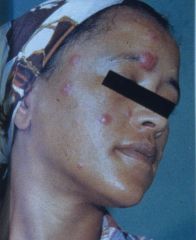
What does this lady have on her face?
|
Sarcoidosis.
|
|
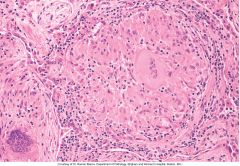
What is this a histology slide of?
|
A sarcoidosis nodule.
|
|
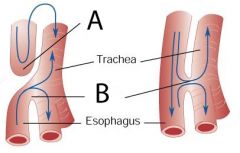
What is A?
|
Esophageal Atresia.
|
|
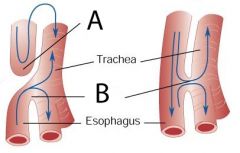
What is B?
|
Trachoesophageal fistula.
|
|
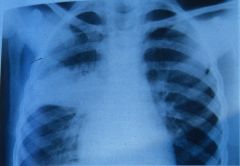
What is this an x-ray of?
|
Pneumonia and an abscess on the right lung. (Looks more solid than cystic fibrosis)
|
|
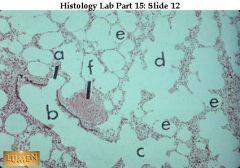
What is this a slide of?
|
Normal, healthy alveoli.
|
|
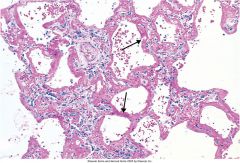
What is this a slide of?
|
Alveoli in acute respiratory distress syndrome. The tissue is very swollen.
|
|
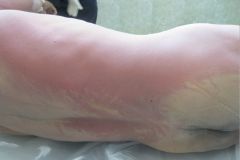
What did this person die of?
|
Carbon Monoxide poisoning.
|
|
|
What is missing from the mucus of someone with cystic fibrosis?
|
Chloride. The chloride - ion pump is defective in someone with cystic fibrosis. Chloride is needed to make the mucus watery.
|
|
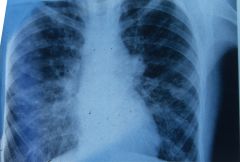
What is the diagnosis of this patient?
|
Cystic Fibrosis
|
|
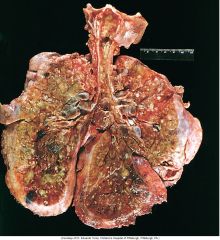
Can you guess what this patient had?
|
Cystic Fibrosis with bronchiectases and also had an infection.
|
|
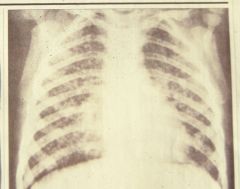
What is this an x-ray of?
|
Diffuse pulmonary fibrosis (or could be cystic fibrosis).
|
|
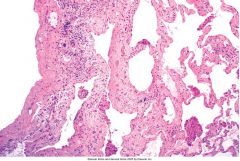
What is this a slide of?
|
Diffuse pulmonary fibrosis. There are a lot of WBCs.
|
|
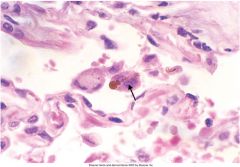
What is this a slide of?
|
Pneumoconiosis. There is an asbestos fiber in the lung tissue.
|
|
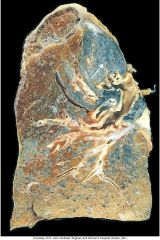
What is this a picture of?
|
Post mortem coal miner's lung. Pneumoconiosis or silicosis.
|
|

What is this an x-ray of and how can you tell?
|
Pneumothorax and lung collapse. The right side of the diaphragm has raised up and the heart has shifted over to that side as well.
|
|
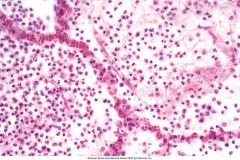
What is this a slide of?
|
Pneumonia
|
|
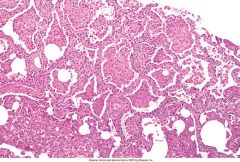
What is this a slide of?
|
Pneumonia with a lot of sputum.
|
|
|
What is hyponatremia?
|
Sodium is low and water is high or normal.
|
|
|
What are the causes of hyponatremia?
|
Too much antidiuretic hormone or too much exercise, where the patient is sweating a lot but only drinking water.
|
|
|
What are the symptoms of hyponatremia?
|
- confusion
- nausea - stomach cramps - convulsions - coma in extreme cases |
|
|
What is hypernatremia?
|
Excess of sodium, water is low or normal.
|
|
|
What are the causes of hypernatremia?
|
- tube feeding
- lacking antidiuretic hormone - prolonged diarrhea - binge drinking |
|
|
What are the symptoms of hypernatremia?
|
- fever
- lethargy - intense thirst - nausea - confusion - headache (FLINCH) |
|
|
What is hypokalemia?
|
Lack of potassium inside the cells.
|
|
|
What are the causes of hypokalemia?
|
- starvation, fasting or dieting
- alkylosis - excess insulin - diarrhea - sweating - diuretics - Cushing's Disease - Stress |
|
|
What are the symptoms of hypokalemia?
|
6 L's
- Lethargy - Leg cramps - Limp muscles - Low, shallow respirations - Lethal cardiac dysrhythmias - Lots of urine (polyuria) |
|
|
What is hyperkalemia?
|
Too much potassium
|
|
|
What are the symptoms of hyperkalemia?
|
- makes everything hyper
- cramping - diarrhea - tetany - exhausted paralysis - overly toned skeletal muscle - tachycardia (but weak contractions, cardiac arrest from exhaustion) |
|
|
What are the causes of hyperkalemia?
|
- Addison's Disease
- Kidney failure (retentive) - acidosis - any tissue trauma (crush injuries, MIs, burns) |
|
|
What is hypercalcemia?
|
Too much calcium in the blood
|
|
|
What causes hypercalcemia?
|
- an excess of parathyroid hormone
- leukemias and multiple myelomas (cancer on the bone) |
|
|
What are the symptoms of hypercalcemia?
|
Moans, stones, bones, groans
mental - reflex slowing (depression) stones - kidney & other tissue stones bones - bone pain and fractures groans - constipation (may also cause heart arrhythmias) |
|
|
What is hypocalcemia and what causes it?
|
Too low calcium.
- Lack of vitamin D - malabsorption syndrome |
|
|
What are the symptoms of hypocalcemia?
|
CATS (Bonnie's cats have diarrhea)
- convulsions - arrhythmias - tetany - spasms, stridor (can also cause diarrhea) |
|
|
What does magnesium do?
|
Prevents release of acetylcholine to the muscle functions at the nerve-muscle connection
|
|
|
What is hypomagnesia and what causes it?
|
Lack of magnesium. Malnutrition or loss of magnesium at the kidney.
|
|
|
What are the symptoms of hypomagnesia?
|
- premature acetylcholine release (hypertone or tetany)
- hyper-reflexes - cramps |
|
|
What is hypermagnesia and what causes it?
|
Excess magnesium. Retentive kidney failure (can't pee) and surviving drowning in the ocean.
|
|
|
What are the symptoms of hypermagnesia?
|
- muscle activity decreased
- decreased muscle tone - heart arrhythmias - flushing - sweating (diaphoresis) |
|
|
What is hypophosphatemia and what causes it?
|
Not enough phosphates.
- malnutrition - kidney washing out - alkalosis |
|
|
What are the symptoms of hypophosphatemia?
|
- symptoms related to lack of ATP function
- poor appetite - neurological weirdness - lower reflexes - parasthesia - heart trouble - breathing trouble - decreased respiration or failure - cardiomyopathy - heart failure |
|
|
What is hyperphosphatemia and what causes it?
|
Excess of phosphates.
- fertilizer exposure - chronic renal failure |
|
|
What are the symptoms of hyperphosphatemia?
|
- hypocalcemia (phosphate binds to calcium)
- hyper reflexes - hyper gut - itchy from salt deposits on skin |
|
|
What does phosphoric acid in soda do?
|
Binds to calcium so increases risk of osteoporosis for people who drink it regularly.
|
|
|
What is alkalosis?
|
Body fluids have excess base, pH higher than 7.4.
|
|
|
What causes metabolic alkalosis?
|
- vomiting
- diuretic therapy - cystic fibrosis |
|
|
What kinds of alkalosis are there?
|
Respiratory and metabolic.
|
|
|
What causes respiratory alkalosis?
|
Low carbon dioxide levels caused by:
- fever - being at a high altitude - lung disease (causing hyperventilation) - salicylate poisoning - hyperventilating |
|
|
What are the symptoms of metabolic alkalosis?
|
- hyper nerves and reflexes
- pins and needles - tetany - overly emotional or confused - convulsions - breathing will be less to compensate |
|
|
What are the symptoms of respiratory alkalosis?
|
- paresthesia
- tetany of the small muscles (like fingers) - sweatiness - dizziness (too much CO2 can be toxic to the brain) |
|
|
What is respiratory acidosis?
|
Too much carbon dioxide in the body. A blood pH lower 7.4.
|
|
|
How many kinds of acidosis is there?
|
Two; metabolic and respiratory.
|
|
|
What is metabolic acidosis?
|
Too much acid in the blood. Blood pH lower than 7.4. Retaining hydrogen at the kidneys.
|
|
|
What are the symptoms of metabolic acidosis?
|
- CNS depression
- sleepy - arrhythmias - increased ventilation |
|
|
What causes respiratory acidosis?
|
- decreased breathing below need
- medications that decrease breathing rate - pneumonia - asthma |
|
|
What are the symptoms of respiratory acidosis?
|
- tachycardia
- blurred vision - tremors - headache |
|
|
What is dysphagia?
|
Trouble eating. Trouble with the mouth, inability to swallow or inability to taste food.
|
|
|
What is odynophagia?
|
Pain when eating. Dental trouble, strictures in the esophagus.
|
|
|
What is pyrosis?
|
Heartburn, acid reflux.
|
|
|
What is emesis?
|
Throwing up.
|
|
|
What is eructation?
|
Burp. Stomach gas, fermentation in the stomach.
|
|
|
Define flatus.
|
Farting. Poor absorption plus lots of bacteria.
|
|
|
What is borborygmi?
|
Stomach gurgles, maybe excess gas.
|
|
|
What is steatorrhea?
|
Fatty bulky diarrhea, malabsorbed.
|
|
|
What is constipation?
|
Decreased motility. The longer it takes to travel, the more water is reabsorbed and the harder it becomes.
|
|
|
What is diarrhea?
|
Excess motility in the gut. Electrolyte balance and hydration can be affected.
|
|
|
What is herpetic stomatitis?
|
A cold sore outside the mouth. Is common, caused by the herpes virus.
|
|
|
What is scurvy stomatitis?
|
Inflammation of the mouth, bleeding gums caused by low vitamin C.
|
|
|
What is nausea?
|
Backwards peristalsis in the esophagus only.
|
|
|
What are aphthous ulcers?
|
Canker sores inside the mouth. Increased risk with stress or Crohn's Disease.
|
|
|
What causes tongue fissures?
|
Usually a vitamin B12 deficiency.
|
|
|
What is leukoplakia and what causes it?
|
A white raised flat surface on the tongue or mucosa. Associated with tobacco use. Increases risk of oral cancer.
|
|
|
What is erythroplakia?
|
Red, raised, lesions with a velvety flat surface. Higher risk of cancer than leukoplakia. Associated with tobacco, smoked or chewing.
|
|
|
What is thrush?
|
Oral candida (yeast) infection. The infection is typically on the tongue. It is white and fuzzy and can be scraped off. People with decreased immunity get it. People stressed, with AIDS, etc.
|
|
|
What causes oral (mouth) or esophageal (throat) cancer?
|
Tobacco and alcohol use. Can also be caused by the papilloma virus.
|
|
|
What is a hiatus hernia?
|
When part of the stomach is above the diaphragm.
|
|
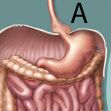
What is A?
|
Hiatal Hernia.
|
|
|
What is Mallory-Weiss Syndrome?
|
Esophageal blood vessels bulging into the esophagus (varicose vessels) that may cause tearing and bleeding.
|
|
|
What causes Mallory-Weiss Syndrome and how is it treated?
|
Can be potentially caused by liver disease, too much aspirin, repeated episodes of vomiting. It is treated by placing a balloon in the area of the esophagus to dilate and hold it and then cauterize the area.
|
|
|
How is pyrosis treated?
|
Acid neutralizers, proton pump inhibiters and histamine 2 antagonists.
|
|
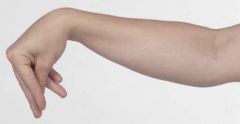
What is this picture an example of?
|
Tetany.
|
|

What is this a picture of?
|
Aphthous ulcer (canker sore)
|
|
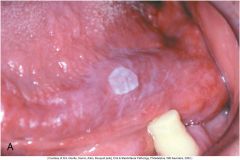
What is this a picture of?
|
Leukoplakia.
|
|
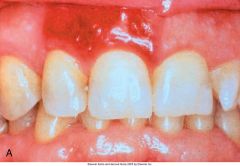
What is this a picture of?
|
Erythroplakia.
|
|
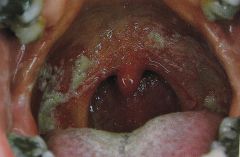
What is this a picture of?
|
Oral Candida or thrush.
|
|
|
What is one way to check if someone is dehydrated?
|
Pinch the skin on the back of their hand. If the skin stays raised, they are dehydrated. If the skin lays back flat, they are not dehydrated.
|
|
|
What is gastritis and what causes it?
|
An inflammation of the stomach only. Can be caused by infection or toxic chemicals.
|
|
|
What are the symptoms of gastritis?
|
- Poor appetite
- vomiting (possible blood in the vomit) |
|
|
What is gastroenteritis and what causes it?
|
Vomiting AND diarrhea. Can be caused by food poisoning, norovirus, rotovirus or other infection. Diarrhea is fierce enough to possibly cause acidosis.
|
|
|
What is helicobacter pylori, also known as H. pylori?
|
A infectious bacteria known to cause gastric and duodenal ulcers.
|
|
|
What are the symptoms associated with H. pylori?
|
Epigastric pain made worse, or soothed, by eating. Early symptoms include nausea and eructation. Later symptoms include pain and vomiting blood that resembles coffee grounds.
|
|
|
What is the treatment for H. pylori.
|
Antacids and antibiotics. When the infection is gone, the antacids can be discontinued.
|
|
|
What is ulcerative colitis?
|
An inflammatory bowel disease in the large intestine or colon, with exacerbations and remissions. It is seen around the world. Causes diarrhea and tissue damage. Abscesses and bleeding ulcers in the intestinal crypts.
|
|
|
What are the symptoms of ulcerative colitis?
|
- Diarrhea
- bleeding - black poop - rebound pain - guarding (abdominal muscles may be tight) |
|
|
How do you determine if someone has rebound pain?
|
Have them go up on their toes and drop on their heels. Will have pain and can pinpoint where it is. Also pushing on the opposite side and pull away fast may also help to locate the pain.
|
|
|
How is ulcerative colitis treated?
|
Fecal transplant (or enema).
|
|
|
What do you have to watch for with ulcerative colitis?
|
Anemia because of bleeding.
|
|
|
What is Crohn's Disease?
|
A chronic inflammatory disease of the intestines, esp. the colon and ileum, associated with aphthous ulcers and fistulae. Can happen anywhere in the intestines. May have a genetic link.
|
|
|
Where is Crohn's Disease seen?
|
Only in first world countries.
|
|
|
Where is Crohn's most commonly seen in the gut?
|
Ileocecal connection.
|
|
|
What is fistulae?
|
An abnormal passage from a hollow organ to the body surface, or from one organ to another. Can leak bowel contents out through the skin with one.
|
|
|
What are the symptoms of Crohn's Disease?
|
- Cobblestone lesions in the intestine
- skipping lesions - fistulae - inflamed lymph vessels - persistant diarrhea - rectal bleeding - abdominal cramps and pain |
|
|
How is Crohns disease treated?
|
- Immune suppressing drugs
- anti inflammatories - diet - stress control - antibiotics (ASAID) |
|
|
What is enterocolitis?
|
Pseudomembrane infections (biofilm infections). An inflammation of the digestive tract, involving enteritis of the small intestine and colitis of the colon.
|
|
|
What are the two kinds of enterocolitis?
|
Pseudomembranous colitis which affects adults and necrotizing enterocolitis which affects newborns.
|
|
|
Describe pseudomembranous colitis.
|
- It is typically post procedure
- post antibiotic - develops massive diarrhea - abdomen is distended Could be C. diff (took your antibiotics and you PAID for it!) |
|
|
Describe necrotizing enterocolitis.
|
- affects premies
- almost always hospital babies (not breastfed) - swollen abdomen - fever - diarrhea - biofilm infection |
|
|
What is appendicitis?
|
An infected, inflamed appendix.
|
|
|
What does the appendix do?
|
Stores bacteria in case it is needed to recolonize the large intestines.
|
|
|
What are the symptoms of appendicitis?
|
- fever
- diarrhea - rebound pain that starts in the umbilical region and moves to lower right quadrant. - can rupture and get peritonitis |
|
|
What is peritonitis?
|
An infection from bacteria in the body cavity (abdomen).
|
|
|
What is diverticulitis?
|
An inflammation of the diverticula, caused when feces gets trapped in them.
|
|
|
What is diverticula?
|
Pouches formed in the wall of the colon. Appearance of these diverticula, without symptoms is called diverticulosis.
|
|
|
What are the symptoms of diverticulitis?
|
- abdominal pain
- fever - diarrhea or constipation - bloating |
|
|
What is IBS?
|
Irritable Bowel Syndrome. It is a problem with the neurons that cause peristalsis.
|
|
|
What are the symptoms of IBS?
|
- Diarrhea and/ or constipation
- discomfort - bloating - change in bowel habits |
|
|
What can cause an obstruction of the gut?
|
- tumors
- adhesions - constipation - infection |
|
|
What are the symptoms of an obstruction?
|
- diarrhea will be foamy
- pencil stool (really skinny poop) - nausea - may vomit stool - distension especially if the colon is blocked |
|
|
Why is an obstructed bowel dangerous?
|
It carries a high risk of ischemia and necrosis. It can rupture causing dead tissue to enter the abdominal cavity. Potentially lethal.
|
|
|
What is a volvolus?
|
A twisted bowel. It often causes an obstruction.
(you twist or turn the steering wheel of the volvo?) |
|
|
What causes a volvolus?
|
- adhesions
- tumors - something eaten that wasn't supposed to (non-food) - magnets swallowed alone or as part of a small toy (MATS) |
|
|
What is an intussusception?
|
Intestine collapses in itself like parts of a telescope. More common in baby boys. Often causes an obstruction.
|
|
|
What symptoms are caused by intussusception?
|
Obstructed bowel symptoms and a "red currant jelly" stool (stool mixed with blood and mucus).
|
|
|
What is Hirschsprung's Megacolon?
|
A congenital disorder when the neurons for peristalsis don't make it all the way to the lower colon. Since there is no peristalsis in the lower colon, feces gets hard and the patient gets constipated.
|
|
|
What is the treatment for Hirschsprung's Megacolon?
|
Remove the portion without the neurons. A person can live without a large intestine.
|
|
|
Name the malabsorption disorders.
|
Celiac disease, post-surgical malabsorption and Tropical Sprue.
|
|
|
What is Celiac disease?
|
An autoimmune digestive disease that damages the small intestine and interferes with absorption of nutrients from food. The people affected by this disease cannot eat wheat, rice or gluten.
|
|
|
What are the symptoms of celiac disease?
|
- Steatorrhea (excess fat in the feces)
- malnutrition issues (like anemias & osteoporosis) - granulomas in place of villi in the small intestine (Bet they can't have MSG!) |
|
|
What is the treatment for Celiac disease?
|
Gluten free diet (or rice free or wheat free).
|
|
|
What is post-surgical malabsorption?
|
Stomach bypass surgery, or trauma causing hypermotility when intestines "dump" their contents, decreasing time to absorb nutrients.
|
|
|
What is Tropical Sprue?
|
A malabsorption disease found in the tropics with symptoms of
- diarrhea - steatorrhea - indigestion - cramps - weightloss - fatigue |
|
|
Describe Gastric cancer.
|
Starts in the mucosa. No symptoms, but is treatable. If it spreads to the submucosa, there may be bleeding. It then may spread to the muscularis. If there is pain and nausea, then it is too late.
|
|
|
Describe colon cancer.
|
Develops from a polyp. Increased risk with age and family history. Also an increased risk with IBS. Caught early, it is very treatable.
|
|
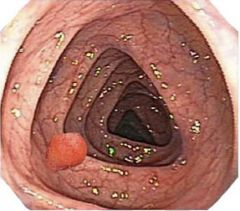
What is this a picture of? What can it turn into if not removed?
|
Polyp. Cancer.
|
|
|
What are the symptoms of colon cancer?
|
- Bleeding like in ulcerative colitis
- obstructive bowel |
|
|
How is colon cancer diagnosed?
|
- blood test
- colonoscopy |
|
|
What is cholelithiasis?
|
Gall stones (made from cholesterol - more with European heritage or bilirubin - more with Asian)
|
|
|
What is cholecystitis?
|
An inflammation or infection of the gall bladder. Usually is associated with cholelithiasis.
|
|
|
What are the risks associated with cholelithiasis?
|
6 'F's and Native American
- fair - female - fertile - fat (malnourished and overeating or rapid weightloss) - flatulant (sign of malabsorption) - Native American - plains tribes |
|
|
What are the symptoms of cholelithiasis?
|
- pain with food (cramping pain)
- light poop (clay colored stool) - jaundiced - itchy - feeling lousy in general |
|
|
What is the treatment for cholelithiasis?
|
Gall bladder removal.
|
|
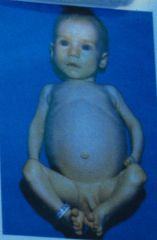
What is wrong with baby and how can you tell?
|
Celiac Disease. Skinny limbs and distended abdomen (likely filled with gas).
|
|

Judging from this picture, can you tell what is wrong with the intestine on the right?
|
Celiac Disease. The intestine on the right is inflamed and has lost the villi that encourages absorption.
|
|

Judging from this picture, can you tell what is wrong with the colon on the right? How can you tell? And what is the black arrow pointing to?
|
Crohn's Disease. It is inflamed. The arrow is pointing to a granuloma.
|
|
|
What's the difference between ulcerative colitis and Crohn's Disease?
|
Crohn's effects the entire thickness of the colon wall where the ulcerative colitis effects only the mucosa. Ulcerative colitis also affects only the large intestine and colon whereas Crohn's can be anywhere in the small and large intestine as well as colon and rectum.
|
|

What is A and what happens when it becomes infected?
|
Diverticulum. Diverticulitis.
|
|
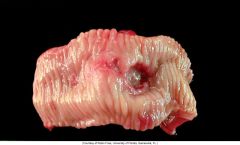
Can you identify this?
|
A peptic ulcer with inflammation.
|
|

Can you identify this and how do you know?
|
Ulcerative colitis because it is consistently irritated. If it were Crohn's, it would have areas that were not infected.
|
|
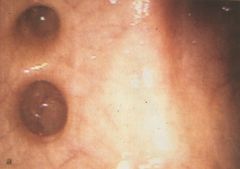
What is this?
|
Diverticulosis.
|
|
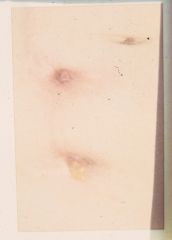
Identify this and what could potentially leak from them.
|
These are fistulas on the abdomen from Crohn's disease. Because it is from the intestines, intestinal fluid or feces could potentially leak from them.
|
|
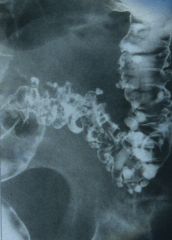
What is this an x-ray of and how do you know?
|
This is an x-ray of a patient with diverticulosis. The diverticula can be seen.
|
|
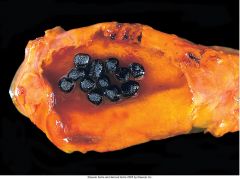
What are we looking at and what is the condition that causes this?
|
Gall stones. Cholelithiasis.
|
|
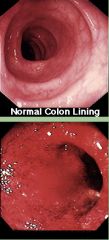
What is wrong with the colon in the picture below the normal colon?
|
Ulcerative colitis.
|
|
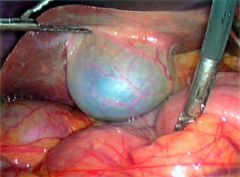
What is this a picture of and how do you know?
|
Healthy gall bladder. It is green.
|
|
|
What is pancreatitis?
|
An inflamed pancreas caused by blocked ducts.
|
|
|
What can block the ducts of the pancreas?
|
- inflammation
- cystic fibrosis - gall stones - tumors |
|
|
What happens when you block the ducts of the pancreas?
|
You trap the enzymes that the pancreas creates, causing a risk of digesting the pancreas. It causes pain and the risk of bleeding.
|
|
|
What can happen with pancreatitis?
|
The pancreas can stop making and releasing enzymes like cholesistikinine (CCK). If this happens, enzymes and insulin will be needed with meals.
|
|
|
What is the treatment for pancreatitis?
|
- pain meds
- IV feeding only for some time - monitor for bleeding - monitor BP |
|
|
What are the risk factors for pancreatitis?
|
Alcoholism, but other than that, it is idiopathic.
|
|
|
What are the 8 liver disorders?
|
1. Jaundice / cholestasis
2. Portal hypertension 3. Cirrhosis 4. Hepatic Failure 5. Hepatitis 6. Alcoholic Liver Disease 7. Storage Diseases 8. Reye's Syndrome |
|
|
What causes Jaundice?
|
When there is an excess of bilirubin made and there is a hemolytic condition (blood being destroyed).
|
|
|
What is cholestasis?
|
When bile is trapped (will cause jaundice).
|
|
|
What causes cholestasis?
|
Bile duct tumors or cysts.
|
|
|
What are the symptoms of jaundice/ cholestasis?
|
- yellow in the eyes and skin tone
- dark urine - xanthomas - pruritis (bile salt builds up on the skin) - increase in liver enzymes (alkaline phosphotase) - decrease in fat soluble vitamins (A,D, E & K) |
|
|
What are xanthomas?
|
Cholesterol deposits in the corner of the eye or elbow.
|
|
|
What happens if cholestasis goes on for too long?
|
Bile can become toxic to the liver and may eventually cause cirrhosis.
|
|
|
What is portal hypertension?
|
The hepatic portal vein has high blood pressure so the blood isn't getting through the liver.
|
|
|
What are the causes for portal hypertension?
|
- right sided heart failure
- clots - tumors - cirrhosis |
|
|
What are the symptoms of portal hypertension?
|
- ascites
- splenomegaly - shunts (trying to bypass the blockage through the abdomen veins - "road map abdomen") - esophageal varisces - varicose veins of the esophagus - hemorrhoids - varicose veins of the anus (ASHES) |
|
|
What is cirrhosis?
|
Damage to the liver, possibly progressive, caused by
- serious injury - necrosis - fibrosis or scarring (literal translation means "orange yellow") |
|
|
What is unique about the liver?
|
It can regenerate when damaged. Nodules of regeneration will develop on the liver, making it bumpy. These nodules, however, can block bile and blood pathways, making cirrhosis a progressive disease.
|
|
|
What happens if a bile path is blocked in the liver?
|
- toxicity induced necrosis
- elevated liver enzymes - cholestasis (TECH) |
|
|
What are the symptoms of a cirrhotic liver?
|
There aren't any until the liver begins to fail.
|
|
|
What is hepatic failure?
|
The loss of 80% or more of liver function.
|
|
|
What are the symptoms of hepatic failure?
|
- jaundice
- portal hypertension sometimes - blood issues - increased liver enzymes - fetor hepaticus - stink of liver in sweat - endocrinopathies - neural symptoms (hand and foot flapping) - hepatorenal syndrome - unstable blood sugar |
|
|
What blood issues can develop because of liver failure?
|
- Disseminated intravascular coagulation (DIC), causing petechiae or purpura
- hypoalbuminemia, causing edema and leukonychia (white fingernails) |
|
|
What endocrinopathies can be caused by liver failure?
|
- an increase in estrogen (liver removes this)
- gynecomastia - breasts in men - palmar erythema - red palms - gonad atrophy - shrinking of the gonads |
|
|
What neural symptoms can be caused by liver failure?
|
- hepatic encephalopathy
- irritable - stuporous - hand and foot flapping (asterixis) |
|
|
What is hepatorenal syndrome?
|
Kidney failure, but if the liver can be fixed, then the kidneys will recover.
|
|
|
What is the treatment for cirrhosis.
|
- Liver transplant
- might be able to reverse toxic failure with anti inflammatory steroids. |
|
|
What is hepatitis?
|
Inflamed liver. There are two kinds; viral and toxic.
|
|
|
Describe viral hepatitis.
|
Caused by an infection. Symptoms include
- malaise - fever - pain in upper right quadrant - lack of appetite - possible jaundice - Hepatitis A is the only one that you can get from food |
|
|
Describe Toxic Hepatitis.
|
Caused by medications, alcohol or other poison.
|
|
|
How will a patient present who has toxic hepatitis caused from alcohol?
|
- an enlarged liver
- fever - high WBC count - light colored poop (HALF) |
|
|
How is Hepatitis treated?
|
- Steroids, if really sick
- high carb diet - check their medications - avoid alcohol |
|
|
Describe alcoholic liver disease.
|
Can start as hepatitis or steatosis (fatty liver), both of which are reversible. They can both seriously injure the liver
|
|
|
When the liver processes alcohol, what is produced and what can happen with it?
|
Aldehydes are created when the liver processes alcohol. People can develop an allergy to the aldehydes and feel sick when they drink.
|
|
|
What is a storage disease and what kinds are there?
|
The liver stores toxins that it isolates from the blood. There are two kinds; hemachromatosis and Wilson's Disease.
|
|
|
What is hemochromatosis?
|
Iron Storage disease - genetically more iron stored than supposed to.
|
|
|
What are the symptoms of hemochromatosis?
|
- enlarged liver
- excess iron to the point it becomes toxic - cirrhosis - insulin dependent diabetes - pancreas damage - skin darkening - gout like symptoms - pain in the joints - eventual multiple organ failure |
|
|
What is the treatment for hemochromatosis?
|
Chelation medications.
|
|
|
What is Wilson's Disease?
|
An autosomal recessive genetic Liver Storage Disease of excess copper. Typically diagnosed early as a child.
|
|
|
What are the symptoms of Hepatolenticular Degeneration?
|
- Copper colored ring around the iris of the eye
- copper builds up in the liver and brain - by age 5 - jaudice - hepatitis - neural symptoms - lens damage |
|
|
What is the treatment for Wilson's Disease?
|
- Try to treat before cirrhosis sets in
- chelation medications |
|
|
What is Reye's syndrome?
|
A potentially fatal disease, associated with children having taken aspirin after a viral infection, although it happens in other conditions as well. More common in children. Inherited with mitochondria on the mother's side.
|
|
|
What are the symptoms of Reye's Syndrome?
|
A child with a pre-existing genetic makeup gets a virus and takes aspirin (ASA). Approximately 5 days later
- vomiting - loss of energy - enlarged liver - 1/4 will go into a coma from ammonia buildup in the brain - 3/4 will get steatosis and recover |
|
|
What is Rhabdomyolosis?
|
It is a muscle-caused kidney disease. Proteins from the muscle choke the filters in the kidneys.
|
|
|
What causes Rhabdomyolosis?
|
- an injury to the muscle associated with exercise in extreme heat with dehydration
- ACE inhibitors like Lipitor (higher risk for geriatric patients) |
|
|
What are the symptoms of rhabdomyolosis?
|
- muscle pain
- weakness in the muscles - nausea - brown, coca cola colored pee - increase in muscle enzymes (CK, myoglobin, troponin, lactate dehydrogenase) |
|
|
What is the treatment for rhabdomyolosis?
|
- alkaline diuretics
- monitor their heart (electrolytes may go out of whack) - possible dialysis - can go into acute kidney failure |
|
|
What is acute kidney failure?
|
Rapid onset of the failing of the kidneys.
|
|
|
What are the symptoms of acute kidney failure?
|
- anuria (no pee)
- oliguria (very little pee) - rapid weight gain associated with hypervolemia - high BP - edema |
|
|
What are the pre-renal causes of acute renal failure?
|
- pre-renal circulatory shock (lack of blood to the kidneys)
- sepsis (especially with clots) |
|
|
What are the inter-renal causes of acute kidney failure?
|
- toxic meds
- inflammation of the kidneys associated with infection - eclampsia associated with pregnancy |
|
|
What are the post-renal causes of acute kidney failure?
|
- anything the blocks outflow
- obstruction of the ureters - stones - tumors |
|
|
What are the stages of acute renal failure?
|
I - oliguria
II - diuretic III - recovery phase (need to be monitored for chronic failure) |
|
|
Describe stage I of acute renal failure.
|
- oliguria
- increase in BP - increase in BUN - increase in urea - increase in creatinine - increase in potassium |
|
|
Describe Stage II (after treatment) of acute renal failure.
|
Diuretic
- water loss - electrolytes need to be monitored |
|
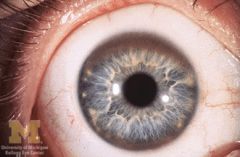
What does this person have?
|
Wilson's Disease.
|
|

What is wrong with this woman and how do you know?
|
Some sort of liver disorder. She is jaundiced with xanthomas.
|
|
|
What is a xanthoma?
|
Cholesterol deposit near the eyes. Associated with liver trouble.
|
|
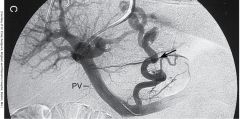
What is this an example of?
|
Caput Medusa. There is portal hypertension and the blood is making an effort to bypass it through this varicose esophageal vein. (yes, it really is an esophageal vein).
|
|

What is this and what is it a sign of?
|
Hypoalbuminemia. Sign of liver trouble.
|
|
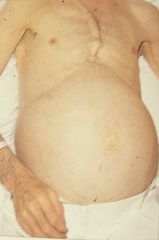
Why is this man's abdomen bloated?
|
Ascites.
|
|
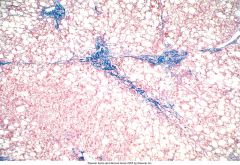
Can you guess what is wrong with this liver tissue?
|
Steatosis, or fatty liver change.
|
|

Can you tell what's wrong with this liver and guess what caused it?
|
Cirrhosis. Alcohol.
|
|
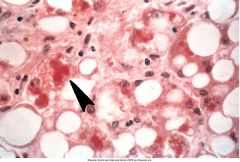
This is a slide of liver tissue. Name the condition.
|
Hepatitis.
|
|
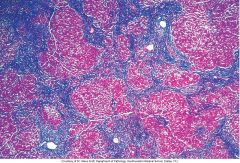
What is this a slide of and what's the blue tissue?
|
Cirrhotic liver. The blue tissue is scar tissue.
|
|
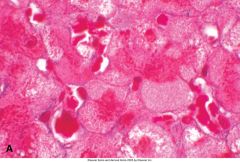
Can you guess what's wrong with this liver tissue?
|
Viral Hepatitis.
|
|
|
What is chronic renal failure?
|
Slow and progressive renal failure, or loss of 65% of kidney function, meaning a kidney can be lost if the other is healthy and still be okay.
|
|
|
What are the causes of chronic renal failure?
|
- could have started as an acute injury
- vascular damage from diabetes - vascular damage high blood pressure - kidney toxic meds - a carrier for sickle cell disease will progress quicker |
|
|
What are the stages of Chronic renal failure?
|
Stage I - when patient show no symptoms
Stage II - renal insufficiency Stage III - late renal failure Stage IV - end stage |
|
|
Describe Stage I of chronic Renal Failure.
|
- no outward symptoms
- creatinine has gone up - patient feels fine - if filtration test is run, it will show a decrease |
|
|
Describe Stage II of Chronic renal failure.
|
Renal Insufficiency
- 75% loss - azotema (urea in the blood - increased BUN) - creatinine is increased - still no outward symptoms - start of anemia - decrease in erythropoietin - bruising - infections, especially UTIs |
|
|
Describe Stage III of Chronic Renal Failure.
|
- 90% loss of kidney function
- increased urea - clotting trouble - infections - anemia - patient not feeling well (fatigue, neuropathy) - uremia - yellow/ bronze skin w/ pink undertones - acidosis - hyperkalemia - headaches - stomach aches - osteoporosis - high BP - low in vitamin D - at this point need a transplant and on dialysis |
|
|
Describe Stage 4 of chronic renal failure.
|
End Stage
- smell of uremia - pruritis (from the urea in their sweat) - uremic frost (urea crystals on their skin) - appetite is bad - all symptoms from last stage are worse |
|
|
What causes UTIs?
|
- anything that can cause decreased urine flow
- sexual contact (urethras get close) - anatomy changes (such as a prolapse) |
|
|
How many different kinds of UTIs are there?
|
Three;
- urethritis - cystitis - pyelonephritis (gotta pee in a CUP to have it tested) |
|
|
Describe Urethritis.
|
Infection of the urethra.
- more common in men (longer urethra) - pain during urination (dysurea) - perineal pain - chlamydia tends not to hurt |
|
|
Describe cystitis.
|
Infection of the bladder.
- more common in women - frequency increases - intensity of urge - cramping after emptying - bacteria, WBCs, nitrates & blood in urine |
|
|
How do you treat cystitis?
|
- antibiotics
- cranberry juice - hydrate before sex (decreases chance of infection) |
|
|
Describe Pyelonephritis.
|
Pus in the kidney and the nephrons are infected. There is a risk of kidney damage. Can develop chronic renal failure. There is acute and chronic.
|
|
|
What causes pyelonephritis?
|
- cystitis can back up the kidney
- could come from a blood infection |
|
|
Describe acute pyelonephritis.
|
- rapid onset
- usually women - sudden, high fever - muscle pain - posterior lumbar pain - interior upper quadrant pain on side of kidney - bacteria, blood, WBCs in urine, casts in urine - urine sample may be cloudy - can cause acute renal failure or kidney damage if bad enough |
|
|
What are casts?
|
Dead kidney cells.
|
|
|
Describe chronic pyelonephritis.
|
- persistent infection ongoing and not a lot of symptoms
- less common - kidney is scarred - gender neutral - vague lower back pain - might have bacteria in the urine (hard to diagnose) - risk of chronic renal failure |
|
|
What is a kidney obstruction?
|
Blockage in the ureter or urethra causing renal failure. Has an increased risk of infection.
|
|
|
What are the symptoms of a kidney obstruction?
|
- cholic type pain (cramping or lumbar pain)
- increased BP - increased urea - blood in urine (hematuria) |
|
|
What are the kinds of kidney obstructions?
|
Urolithiasis and cancer.
|
|
|
Describe urolithiasis.
|
Kidney stones (renal calculi)
- common - crystalized structures formed in the urine and blocks ureter. |
|
|
What are the risks for urolithiasis?
|
- those that don't drink enough fluid
- if the pH is abnormal - if have gout - if a really high protein diet is followed - sulfa drugs - genetics - age |
|
|
What are the symptoms of urolithiasis?
|
- crystals
- blood in the urine - protein in the urine - pain (10 on the scale) - increased repeated UTIs |
|
|
What is the treatment for urolithiasis?
|
- immediately get a catheter and get it out
- if urea levels are going up, then pain meds and strain pee until the stone is passed |
|
|
What kinds of cancer affect the renal system?
|
- Renal Cell carcinoma
- urothelial, or transitional, cell carcinoma - Wilm's tumor |
|
|
Describe Renal Cell Carcinoma.
|
- seen in older people 50-70 years
- more common in men - symptoms are sketchy - 60% will have blood in the urine - BP slightly high - 5% might get lumbar pain - 5-10% RBC increases - polycythemia and slight increase in BP |
|
|
What is the treatment of renal cell carcinoma?
|
Surgery. If it's caught pre-metastatic, then it's cured.
If post metastatic, there is now a specific chemo for it. |
|
|
What is good about the renal cell carcinoma?
|
When it does metastisize, it doesn't travel to the abdomen because renal cell travels behind the peritoneum of the body. There may be disruption of kidney function or nerves to the legs, but there will be no ascites.
|
|
|
Describe urothelial, or transitional, cell carcinoma.
|
This is cancer of the mucosa of the bladder, ureter or kidney pelvis, but not of the nephrons. A cystoscopy will show a mass.
|
|
|
Who is at risk for getting transitional cell carcinoma?
|
- smokers
- lab workers - sewerage treatment workers |
|
|
What are the symptoms of urothelial or transitional cell carcinoma?
|
- blood in the urine
- sometimes an irritable bladder |
|
|
What is the treatment for urothelial or transitional cell carcinoma?
|
Remove the tumor and monitor. The mass may reoccur.
|
|
|
What is Wilm's tumor?
|
- typically a pediatric cancer, kids under 10
- nephroblastoma (in the nephrons) - usually a mass is discovered with an abdomen check - kidney can get massively huge - about 50% will have high BP - about 10% will have blood in the urine |
|
|
What is the treatment for Wilm's tumor?
|
- surgery for a cure of about 85% of patients
- the other 15% may need chemo because it metastisized - the kidney gets large before it metastisizes |
|
|
What is Glomerular Disease?
|
Filter damage or inflammation of the nephron. Can be primary or secondary.
|
|
|
Describe Acute Glomerulonephritis.
|
- Rapid onset of inflammation on the filter of the nephrons of the kidneys.
- seen in children over 3 and more in adults - most common after infection like strep - either antibody/ antigen complexes are going to get stuck at the filter and trigger inflammation (type 3) or antibodies recognize and bind to the filter and trigger inflammation. |
|
|
What are the symptoms of acute glomerulonephritis?
|
- typically 1-6 weeks after infection
- there is swelling in the filters - there is loss in the space of the filters (filled with WBCs) - will either get acute renal failure and treat with anti inflammatories (steroids) & dialysis OR get nephrotic syndrome |
|
|
Describe nephrotic syndrome.
|
- holes in the filter at the glomerulus due to immune attack
- no filtration - blood in the urine (hematuria) - proteinuria (albumin & clotting proteins make it foamy) - anemia and increased infection risk - spontaneous bruising in legs (proteins & platelets) - wandering edema - can get muscle loss (loss of proteins) - bone demineralization (loss of calcium) |
|
|
What is the treatment for nephrotic syndrome?
|
- steroids for pediatrics
- possibly a 'no artificial diet' |
|
|
How many kinds of glomerular disease is there?
|
There are 4 kinds; Acute Glomerulonephritis, Nephrotic syndrome, Rapidly Progressing Glomerular Nephritis and Chronic Glomerular Nephritis.
|
|
|
Describe Chronic Glomerular Nephritis.
|
- slower progression
- idiopathic - slow increase in thickness of the filters - flares of symptoms with protein and blood in urine , then goes away - slow increase in BP - eventually will get chronic renal failure and will be treated symptomatically |
|
|
What are the congenital disorders of the urinary system?
|
- Agenesis
- Horse Shoe Kidney - Extrophic bladder - Choaca |
|
|
Describe agenesis.
|
Born with a missing kidney, or no kidneys. If born without a kidney, will be stillborn.
|
|
|
Describe horseshoe kidney.
|
- The two kidneys are joined and looped around the vena cavae.
- Often accompanies syndromes like Turners - there's often trouble with infections. |
|
|
Describe Extrophic bladder.
|
Born with the bladder outside the body. It is easy to fix surgically.
|
|
|
Describe Choaca.
|
- There is one opening for urine, feces and reproductive structures.
- can be surgically corrected - will be genetically tested. |
|
|
What is polycystic kidney disease?
|
- A genetic disease with clusters of cysts in the nephrons
- kidney gets enlarged - kidney will "bounce" - will put person in chronic renal failure - pediatric and adult onset |
|
|
Describe pediatric polycystic kidney disease.
|
- child onset
- autosomal recessive (no gender difference) - in utero, less amniotic fluid (doesn't pee as much as should), so less lung maturity and may die from lung failure - young kids with renal symptoms and renal failure - teens have portal hypertension and can progress to liver failure. |
|
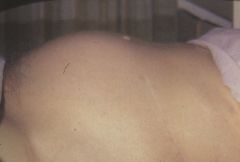
What are we looking at here?
|
Distended bladder due to acute urine retention.
|
|
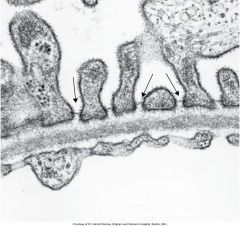
Can you identify this structure? What is above and what is below the endothelia (the line in the middle)?
|
This is a glomerular filter. The cells above are podocytes and the cells below are capillary cells.
|
|

Based on the picture above, what is wrong with the glomerulus on the right and how do you know?
|
Glomerulonephritis, because there is no open space. It is taken up by WBCs.
|
|
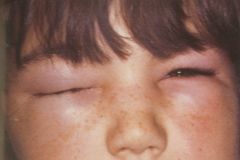
What do you think this child has and why?
|
Nephrotic syndrome because the face has swelling (wandering edema).
|
|
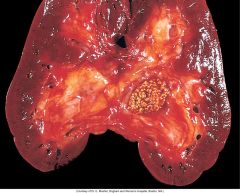
What is wrong with this kidney and what is the structure in it?
|
Nephrolithiasis/ urolithiasis. Kidney stone.
|
|

What is wrong with this kidney (besides the fact that it's not in it's owner ;-)?
|
Pyelonephritis. Pus in the kidney (necrosis).
|
|

What's wrong with this kid and how do you know?
|
He's in the late stages of chronic renal failure. His face is yellow, but his eyes are not.
|
|

What is wrong with the person in this x-ray? How do you know?
|
Urolithiasis/ Nephrolithiasis. There is a "staghorn" shaped kidney stone.
|
|
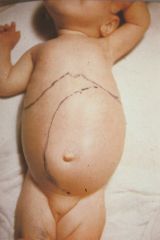
What is wrong with this baby? How can you tell?
|
Wilm's tumor. Distended belly here has a very enlarged kidney.
|
|

What are we looking at here?
|
A Wilm's tumor - takes up most of the kidney.
|
|
|
Describe adult onset of polycystic kidney disease.
|
- autosomal dominant
- common - around 40's or 50's start getting vague symptoms - blood in urine - increased rate of UTIs - kidney gets enlarged - about half have high BP - increased risk of aneurysms - progresses to renal failure |
|
|
How do you treat adult onset polycystic kidney disease?
|
Dialysis and transplant (but not from a family member)
|
|
|
Describe renal trauma.
|
- blunt trauma to the back or abdomen
- patient will have major bleeding - if patient has minor bleeding (blood in urine) - could be a marathoner - lumbar pain - if minor, treated with bed rest |
|
|
Describe bladder trauma.
|
- When the bladder is full, or partly, full and has an abdominal impact.
- can rupture - patient can't void - treated with a catheter |
|
|
Describe incontinence?
|
- Unable to retain urine (or feces) - for this - urine.
- easily treatable with meds - overactive bladder - bladder can't fully stretch - pelvic floor weakness is treated with kegel exercises. |
|
|
Name the conditions from this set that you would see tetany.
|
- Hyperkalemia
- Hypocalcemia - Hypomagnesemia - alkalosis |
|
|
Of the conditions we've seen in this set, which condition would cause a "foamy" stool?
|
An obstruction in the GI tract.
|

